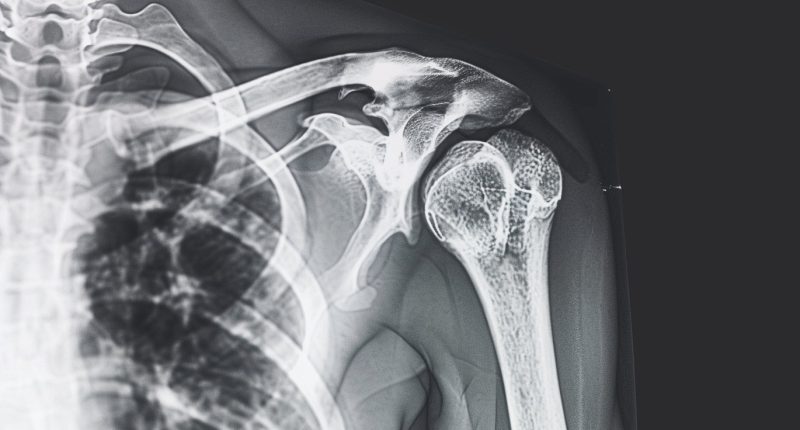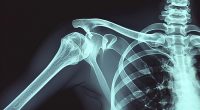Shoulder Fracture
About the disease
A shoulder fracture, or fracture of the greater tubercle of the humerus (which will be discussed in this article), is a loss of the bone the integrity in the area of the rotator cuff of the shoulder, which is responsible for movement in the shoulder joint.
This type of injury presents specific diagnostic challenges. Despite the insignificance of the damage, such fractures need active management. It is essential to ensure the complete regeneration of bone tissue to preserve the arm’s functional fullness in the area of the shoulder joint.
The main symptoms of a fracture are pain and discomfort in the shoulder, minor swelling, hematomas, and impaired joint mobility. The diagnosis is made based on the results of a radiologic examination.
Depending on the severity of the injury, treatment can be performed conservatively or with surgery. An orthopedic traumatologist will select the optimal treatment program based on additional diagnostics.
Types
Closed fractures of the greater tubercle of the humerus are of 3 types, according to Patte classification:
- The first type is the cap type, in which the shoulder rotator cuff is torn.
- The second type is partial – approximately 50% of the greater tubercle is torn off (this is the most common type of fracture). The greater tubercle is torn in the area of attachment of the supraspinous muscle. The second type of fracture is the most difficult to diagnose.
- The third type is total, where the head is torn off the entire humerus length. It means that the function of the shoulder joint is significantly impaired (the tubercle to which the supraspinous, plantar, and small round muscles are attached is torn off).
Fractures of the greater tubercle of the humerus can be displaced and non-displaced bone segments. The third type of fracture is often displaced.
According to the nature of the fracture line, the following types are distinguished:
- splintered;
- tear-off;
- regional;
- embedded.
Symptoms
Fracture of the greater tubercle of the shoulder is often combined with the following injuries:
- anterior dislocation of the humerus;
- damage to the peripheral nerve fibers of the brachial plexus;
- fracture of the neck of the humerus.
When the fracture is complicated by paralysis of the deltoid muscle, the clinical picture is characterized by minor pain (sometimes absent), limited shoulder flexion and extension (no more than 45°), and the almost complete impossibility of external rotation and extension. The picture is complemented by an inferior subluxation of the shoulder, which cannot be repositioned (the head of the shoulder is not held in the proper anatomical position).
Reasons
The fracture of the greater tubercle of the humerus is an avulsion fracture. It means that the integrity of the bone is disrupted by mechanical trauma (fall, hit) or by sudden contraction of the attaching muscles with tearing of the tubercle.
Diagnosis
Preliminary diagnosis is established based on clinical data, as well as the results of objective examination. The final diagnosis can be confirmed by X-ray scanning. Radiography must be performed in 2 projections because the fragment displacement to the rear is not visible on a straight projection.
Treatment of a fracture of the greater tubercle of the humerus
Treatment of this injury can be conservative and surgical. The optimal treatment program is selected based on the characteristics of the clinical case. After the dislocation is corrected, the dislocation is most often repositioned, and surgical treatment is not required. If conservative measures do not eliminate the dislocation, the patient should be operated on as soon as possible.
Conservative treatment
Conservative management is indicated for incomplete fractures without displacement. A plaster cast is applied for several weeks to ensure optimal conditions for bone regeneration.
Surgical treatment
The surgical intervention consists of fixation of the torn-off large tubercle of the shoulder with screws or an eight-shaped tension loop. The latter option is preferable because it allows you to do without a plaster cast and start rehabilitation exercises from the first days after surgery. This fixation method is more stable even with concomitant fracture of the shoulder neck. After the operation, the arm is placed on a brace, and passive movements in an inclined position are prescribed. Careful active movements are started from the 4th to the 6th week.
If complications develop, in particular impingement syndrome, subacromial decompression surgery may be required in the delayed period (2-2.5 months later).
All these treatment options are available in more than 890 hospitals worldwide (https://doctor.global/results/diseases/shoulder-fracture). For example, osteosynthesis can be performed in 29 clinics across Turkey for an approximate price of $3.9 K (https://doctor.global/results/asia/turkey/all-cities/all-specializations/procedures/osteosynthesis).
Prevention
Prevention focuses on injury prevention and gradual dosed strengthening of the muscular corset surrounding the shoulder. While not all fractures can be prevented, some general tips include:
- Using protective gear during high-impact sports
- Strengthening shoulder muscles through regular exercise
- Practicing good posture to reduce strain on the shoulder.
Rehabilitation after fracture of the tubercle of the humerus
Early rehabilitation after a fracture of the greater tubercle of the humerus is possible if the bone fragments are securely fixed. Individualized physical therapy exercises, physiotherapy, and healing massage are recommended after the bone fragments have fused (consolidated fracture).
Conclusion
A fracture of the greater tubercle of the humerus is a significant injury that can impact shoulder function. Understanding the injury, following the prescribed treatment plan, and engaging in rehabilitation are crucial steps for a successful recovery. With appropriate management, most individuals can expect to regain full function and return to their normal activities.




